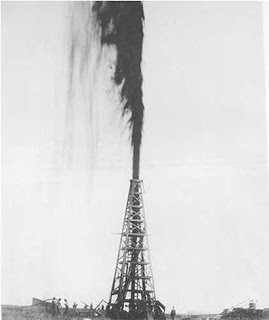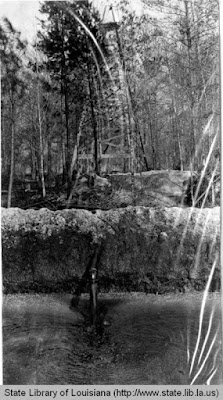 |
| Lucas Gusher, Spindletop Hill, Texas, 1901 |
Did you know that Louisiana is among the top ten producers of crude oil in the United States? The beginning of the American oil industry came when on Jan. 10, 1901, a drilling derrick at Spindletop Hill near Beaumont, Texas, produced an enormous gusher of crude oil, coating the landscape for hundreds of feet. News of the Lucas Gusher was heard around the world and ignited "oil fever." Oil prospecting became a big business. People were anxious to make similar discoveries and investors began shelling out tons of money searching for oil.
In 1909, the first oil well that struck oil in this parish was located at Oakland Plantation. Though it was deemed a success because the goal was to find oil and that they did, they felt the vein they struck was too small and decided against extracting it. The oil well was relocated and led to the discovery of natural gas in that section, a common occurrence when prospecting for oil. Nonetheless, the news of striking oil was received with joy throughout the parish and fueled the desire to find more oil here.
 |
| R.O. Roy, 1938 Owner of R.O. Roy & Company |
 |
| Bellevue Field oil wells, Bossier Parish, early 1900s Written on the photo: Nacatoch sand well at 305 feet, Flowing 1200 barrels a day. |
According to an article by W.S. Ingram published in The Shreveport Times in 1926, "it was the Bellevue shallow field that wrote a new chapter into oil history of the United States." He also stated that "Other wells quickly followed, what was believed the world's shallowest hole flowing 400 barrels from 289 feet, and one of the largest, flowing 3,500 barrels from 336 feet. The total production of this shallow field for the first six months being pipeline runs of 103,700 barrels. The production of this marvelous field for the year ending October 1, 1925, totaled (official figures) 1,327,068 barrels. For the same period there were 32 completions, three being gassers, and 12 producers with initial production of 3,623 barrels.
"This wonder field became the talk of the country and because of the unheard of depth at which the initial production of 1,500 barrels through a two-inch pipe, was obtained, most people were inclined to discount reports of the production. But a visit to the jungle where the holes were located soon convinced the most skeptical. The hole was drilled with a light rotary rig, the table being not more than 30 inches in diameter and the derrick only 38 feet high 'watch charm rigs' as they were termed by a Texas operator. But this field has produced millions of dollars of oil, has caused to be constructed physical property worth millions more and brought Bossier parish and north Louisiana into the limelight of the oil and gas world."
By: Amy Robertson
No comments:
Post a Comment